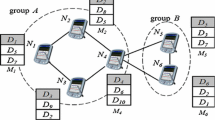Abstract
In line with traditional communication systems, more and more attention is given to autonomous, self-organized networks with no central infrastructure, based on peer-to-peer communication, like mobile ad hoc networks. Designing multihop broadcast protocols for ad hoc networks is a complex problem as the task of these protocols is to disseminate messages in a network effectively while avoiding unnecessary use of resources. To solve this problem, this paper presents three adaptive multihop broadcast protocols, which assign broadcasting probabilities to the mobile nodes, determining them from the network parameters (like the degrees of the nodes, distance of the nodes from each other). The presented novel 3-phase handshake gossiping protocols generate significantly less duplicates while giving a faster coverage of the nodes than the other examined protocols.



Similar content being viewed by others
References
Basagni, S., Conti, M., Giordano, S., & Stojmenovic, I. (2004). Mobile ad hoc networking. Newyork: IEEE Press John Wiley.
Juang, P., Oki, H., Wang, Y., Martonosi, M., Peh, L. S. & Rubenstein, D. (2002). Energy-efficient computing for wildlife tracking: Design tradeofs and early experiences with ZebraNet. In Proceedings of ASPLOS-X, San Jose, CA, USA.
Burgess, J., Gallagher, B., Jensen, D. & Levine, B. N. (2006). Maxprop: Routing for vehicle-based disruption-tolerant networks. In Proceedings of IEEE INFOCOM.
Burleigh, S., Hooke, A., Torgerson, L., Fall, K., Cerf, V., Durst, B., et al. (2003). Delay tolerant networking: An approach to interplanetary internet. IEEE Communications Magazine, 41, 128–136.
Fall, K. (2003). A delay tolerant network architecture for challenged internets. In Proceedings of ACM Sigcomm. Karlsruhe, Germany.
Hanbali, A. A., Ibrahim, M., Simon, V., Varga, E., & Carreras, I. (2009). A survey of message diffusion protocols in mobile ad hoc networks. In Proceedings of InterPerf. Athen, Greece.
Tonguz, O. K., Wisitpongphan, N., Parikh, J. S., Bai, F., Mudalige, P. & Sadekar, V. K. (2006). On the broadcast storm problem in ad hoc wireless networks. In broadband communications, networks and systems, BROADNETS 2006. 3rd international conference on, San Jose, CA, USA.
Ni, S.Y., Tseng, Y.C., Chen, Y.S. & Sheu, J.P. (1999). The broadcast storm problem in a mobile ad hoc network. In Proceedings of MobiCom (pp. 151–162). New York, USA.
Tseng, Y.-Ch., Ni, Sz.-Y., & Shih, E.-Y. (2003). Adaptive approaches to relieving broadcast storms in a wireless multihop mobile ad hoc network. In Proceedings IEEE transactions on computers, vol. 52, no. 5.
Carle, J., Cartigny, J., & Simplot, D. (2002). Stochastic flooding broadcast protocols in mobile wireless networks. Technical report 2002–03. LIFL University Lille 1, France..
Khelil, A., Marron, P. J., Becker, C., & Rothermel, K. (2007). Hypergossiping: A generalized broadcast strategy for mobile ad hoc networks. Ad Hoc Networks, 5, 531–546.
Lu, X. & Peng, W. (2000). On the reduction of broadcast redundancy in mobile ad hoc networks. In Proceedings of Mobihoc.
Varga, E., Csvorics, T., Bacsardi, L., Berces,M., Simon, V. & Szabo, S. (2007). Novel information dissemination solutions in biologically inspired networks. In Proceedings of ConTEL. Zagreb, Croatia.
Heinzelman, W. R., Kulik, J., & Balakrishnan, H. (1999). Adaptive protocols for information dissemination in wireless sensor networks. In Proceedings Seattle: MOBICOM.
Kokuti, A., & SImon, V. (2012). Location based data dissemination in mobile ad hoc networks. In Telecommunications and signal processing (TSP), 2012 35th international conference (pp. 57–61). Prague.
Korkmaz, G., Ekici, E., & zgner, F. (2007). Black-burst-based multihop broadcast protocols for vehicular networks. IEEE Transactions on Vehicular Technology, 56, 3159–3167.
Xu, K., Gerla, M. & Bae, S. (2002). How effective is the IEEE 802.11 RTS/CTS handshake in ad hoc networks. In Global Telecommunications Conference vol. 1, (pp. 72–76).
Kima, J. S., Zhang, Q. & Agarwal, D.P. (2004). Probabilistic broadcasting based on coverage area and neighbor conformation in mobile ad hoc networks. In IEEE global telecommunications conference workshops.
Jungkeun, Y., Mingyan, L., & Brian, N. (2003). Random waypoint considered harmful. In IEEE INFOCOM.
Author information
Authors and Affiliations
Corresponding author
Rights and permissions
About this article
Cite this article
Simon, V., Kőkuti, A. Location based multihop communication in mobile ad hoc networks. Telecommun Syst 59, 523–530 (2015). https://doi.org/10.1007/s11235-014-9912-5
Published:
Issue Date:
DOI: https://doi.org/10.1007/s11235-014-9912-5




